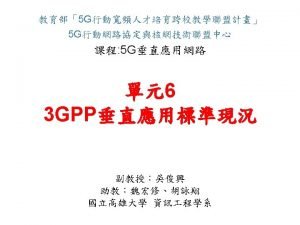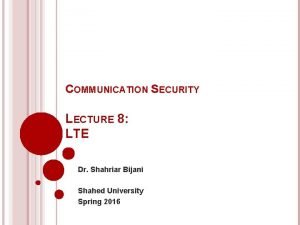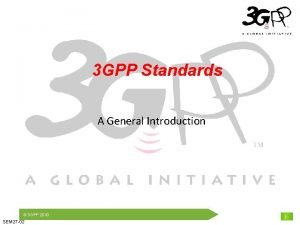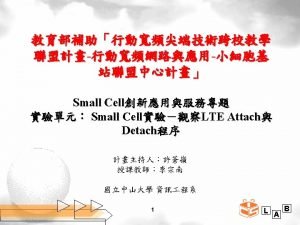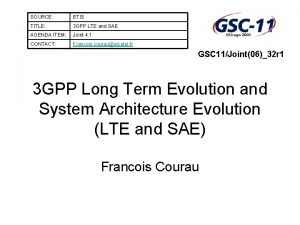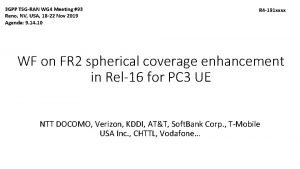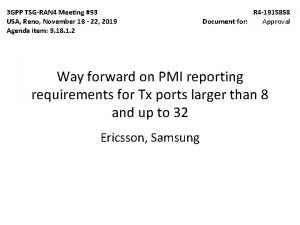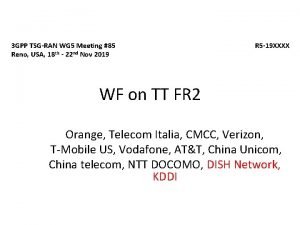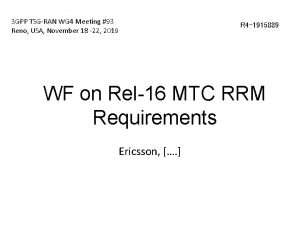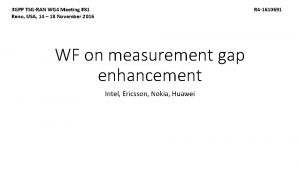3 GPP TSGRAN WG 4 Meeting 81 Reno






- Slides: 6

3 GPP TSG-RAN WG 4 Meeting #81 Reno, Nevada, USA, 14 - 18 November, 2016 Agenda Item: 8. 19. 4. 2 R 4 -1610701 WF on V 2 V power imbalance tests LGE, [Huawei, Hi. Silicon], …

Background • During Rel-12, Power imbalance test for D 2 D was introduced [R 4 -155118] – The purpose of power imbalance test is to check the demodulation performance when receiving PSSCH transmissions from two sidelink UEs with large power imbalance in one subframe. • For information, following methodology was used for power imbalance of Rel-12 D 2 D – – The target requirement ICS = -21 d. Bc depends on IBE Select SINR 2 from simulation results for decoding SNR@70% throughput point. Select SNR 2 such that SNR 2 >> SINR 2 (e. g. , 5 d. B higher) Compute SNR 1 from the relation: SINR 2 = SNR 2 – 10*log 10(10^((SNR 1 + ICS)/10)+1). 2

Background • For Rel-14 V 2 V, PSCCH is always transmitted with its scheduled PSSCH with 3 d. B higher PSD. – Link 1 will be more affect on Link 2 receiving performance. 3

Way Forward • Agree on introducing power imbalance test for V 2 V demodulation requirements – Reuse existing D 2 D methodology as baseline – Once ICS and SINR 2 values are decided, SNR 1 and SNR 2 value can be calculated by agreed equation. • How to handle 3 d. B boosted PSCCH impact – Option 1. Consider modified SNR calculation equation • SINR 2 = SNR 2 – 10*log 10(α * 10((SNR 1+ICS)/10) + 1) – α = (2*NPRB-PSCCH+NPRB-PSSCH)/(NPRB-PSCCH+NPRB-PSSCH) – Option 2. Use non-adjacent PSCCH/PSCCH transmission – Option 3. The impact should be already captured in the IBE requirement. There is no need to consider it here. 4

Way Forward • ICS(In-Channel Selectivity) values – Option 1. Reuse existing D 2 D ICS value of -21 d. Bc. – Option 2. Defer until IBE requirement is finalized in RF room. – Other options are not precluded. • In next meeting, interesting companies are encouraged to propose specific ICS value based on analysis. 5

Simulation assumptions • In next meeting, interesting companies are encouraged to submit simulation results to decide SINR 2 values Proposals V 2 V Test/Simulation parameter To evaluate SINR 1 for power imbalance AGC settling time 1 QPSK: 1 symbol Tx EVM 10% Propagation channel Static : H = [ 1; 1] Doppler spectrum N/A Option 1: No To/Fo Timing & Frequency error 2 (Sync reference and V 2 V Tx) Option 2: [± 12 Ts] / [± 600]Hz HARQ retransmissions 3 [0] PSSCH RMC [3] PRB with MCS 10 (QPSK, R=2/3) Performance metric SNR @ x% [BLER]/[Throughput] Note 1. Not used for demodulation Note 2. Same timing and frequency errors Sync reference and V 2 V Rx are considered to derive simulation results Note 3. Soft-combining is used if HARQ retransmission is used 6
